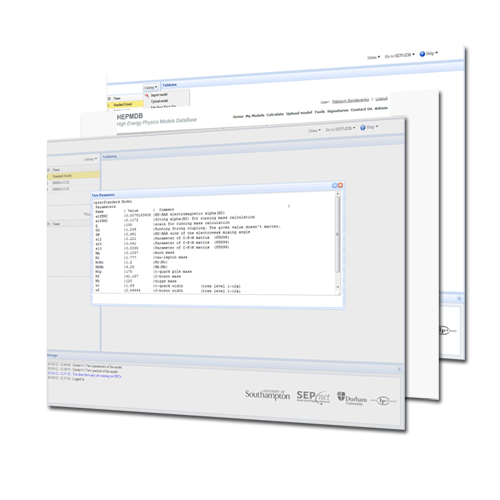Difference between revisions of "HEPMDB"
m |
m |
||
| Line 3: | Line 3: | ||
<td width="100%" valign="top"> | <td width="100%" valign="top"> | ||
| − | HEPMDB is created to facilitate the connection between High Energy theory and experiment, to store and validate theoretical models and to develop a dictionary of the model signatures which | + | HEPMDB is created to facilitate the connection between High Energy theory and experiment, to store and validate theoretical models, and to develop a dictionary of the model signatures which identifies the fundamental theories responsible for signals expected at the LHC. |
HEPMDB is also designed to collect different signatures of its models and their respective experimental efficiencies. Using this information, HEPMDB will be able to compare its BSM model predictions with LHC data. In doing so, HEPMDB will be able to discriminate an underlying theory. | HEPMDB is also designed to collect different signatures of its models and their respective experimental efficiencies. Using this information, HEPMDB will be able to compare its BSM model predictions with LHC data. In doing so, HEPMDB will be able to discriminate an underlying theory. | ||
Revision as of 10:12, 31 July 2013
|
HEPMDB is created to facilitate the connection between High Energy theory and experiment, to store and validate theoretical models, and to develop a dictionary of the model signatures which identifies the fundamental theories responsible for signals expected at the LHC. HEPMDB is also designed to collect different signatures of its models and their respective experimental efficiencies. Using this information, HEPMDB will be able to compare its BSM model predictions with LHC data. In doing so, HEPMDB will be able to discriminate an underlying theory. The database is in the development stage and your input in the 'Forum' section is highly appreciated. Database collects Particle Physics Models. These models are supposed to be public and represent themselves a set of Feynman Rules which can be in form of input for any of Matrix Element generators such as CalcHEP, CompHEP, FeynArts, Madgraph, SHERPA, WHIZARD. HEPMDB has an entrance for Model authors -- 'Authors' -- where Authors can test and validate their models. To become an 'Author', you should register in a 'Register' section. 'Authors' are welcome to upload LanHEP or FeynRules source of their models. If you are new here, you should start with the FAQ. |
